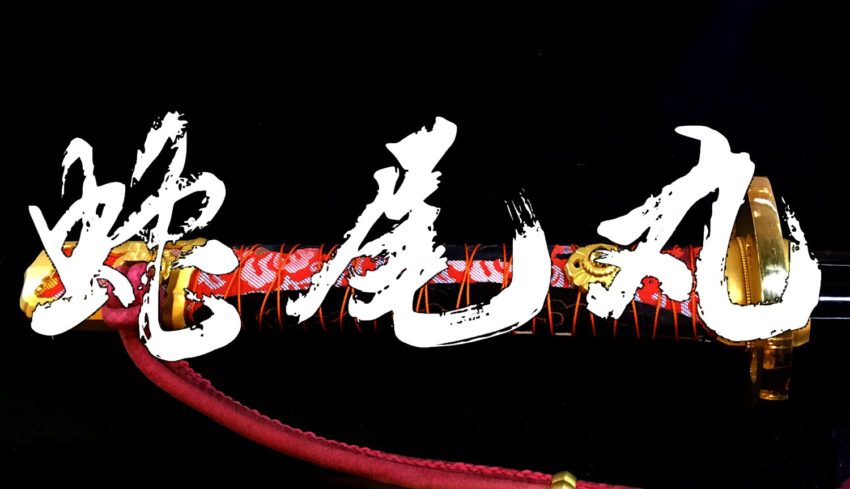The Bard once wrote “What’s in a name? A rose by any other name would smell as sweet.” While names may not dictate what something is, a good name can do a great deal of the work in being made memorable. This article is dedicated to highlighting some notable examples of great Japanese sword names, be they from our world or from the fantasy worlds of page, screen or monitor.
Mugenjin: “Hailing From the Abyss”
Depending on the characters and pronunciation, this weapon can be read as “one hailing from the abyss” or “one hailing from infinity.” This was a finely serrated blade used by Shishio Makoto in the anime and manga Rurouni Kenshin. Notably, its design allows him to extract and retain the fat from where the finely serrated blade struck, giving Shishio fuel to coat the blade in flames.
With a skill like that, the very name Mugenjin stirs up feelings of power and lethality that is as vicious as it is … well, practical.
Shisui: “Water Stopper”
This weapon’s name translates as “water stopper.” It was a guardless, pale wood katana used by Love Hina‘s Motoko Aoyama. The name likely comes from the weapon’s ability to cut through the flow of a waterfall.
Suzaku
Some Japanese sword names take their appellations from folklore. This particular weapon, a ninjatoNINJATO 忍者刀 "ninja sword" learn more... from the Samurai Showdown franchise of fighting games, is just such a weapon. Suzaku is one of the directional guardians, depicted as a flaming bird affiliated with the southern direction.
Zantetsuken: “Iron-Cutting Blade”
Some Japanese sword names are so cool that they have transcended one particular piece of media and saturated pop culture. This particular weapon, whose name translated as “iron (or steel)-cutting blade,” is just such a sword. Zantetsuken has been used by Lupin III‘s Goemon Ishikawa XIII (himself grandly named) to cut through anything the rogues might possibly need removed from their path.
This weapon also appears in several Final Fantasy games, usually when summoning Odin. While some games give the Odin summon more than one means of attack, his Zantetsuken sword is an instant-death attack that is useful for mopping up groups of enemies.
Kusanagi-no-Tsurugi: “Grass Cutter”
Without bogging our discussion down with the lengthy history of this very real weapon, which also happens to account for one-third of Japan’s imperial regalia, this weapon’s impressive-sounding title means “grass cutter.” Some people familiar with the Legend of Zelda games might recall the term “lawn mower” by having Link run down a line of bushes and “mowing” them with his sword to reveal rupees and other items.
But in fact, the Kusanagi-no-Tsurugi got its name after a warrior swung it in desperation. The warrior was dealing with an corrupt samurai in a grassy field of a war zone. Said samurai ignited the field and dispatched the warrior’s horse, leaving him with nowhere to go but to be burnt up by the encroaching blaze that had encircled him. With no other option available, the warrior waved the sword, an heirloom, in such a way that it might blow the flames away. Much to everyone’s astonishment, the weapon called upon the winds and redirected the flames. The warrior used Grass Cutter to hack at the grass, sending expanses of burning grass blowing toward the samurai.
If you don’t think this is on of the most awesome Japanese sword names then you didn’t read that last paragraph!
Shichishito: “Seven-Branched Sword”
Unlike most of the Japanese sword names mentioned in this article, Shichishito is from a sword whose design does not lend itself to combat. The weapon has a unique aesthetic that has become far more prolific than its name; this is absolutely no regular katana.
The Shichishito’s main blade branches off into six alternating prongs. Considering the fact that this item lacks a hole for the tang to be fitted to a hilt, and the branching prongs are not made of the sturdiest of metals, this particularly striking weapon (whose name translates as the “seven-branched sword”) was likely used for some sort of ritual ceremony. The Shichishito is allegedly housed within Nara Prefecture’s Isonokami Shrine.
Japanese Sword Names in Bleach
When thinking of the countless examples of awesome Japanese sword names in anime and manga, especially when the media contains far more such examples than real life, the “soul-cutting swords” of Bleach are one of the first groups that you may want to consider. This section will highlight some of the more notable and sword-like powered-up forms of major characters’ iconic weaponry, known as shikai and bankai.
Note that some shikai forms are decidedly non-sword-like and will only be mentioned here if their weapon has an incredibly cool name.
Zangetsu: “Slaying Moon”
The name of this weapon, wielded by series protagonist Ichigo Kurosaki, translates as “Slaying Moon.” In keeping with the lunar theme of its name, this weapon is capable of launching crescent-shaped energy blasts with devastating power. When Ichigo unlocks the full potential of Zangetsu, the weapon becomes known as “Tensa Zangetsu,” which means “Heaven Chain Slaying Moon.”
Nozarashi: “Weather-Beaten One”
This weapon, which belongs to the insanely strong Kenpachi Zaraki, is a nodachiNODACHI 野太刀 "field sword" learn more... that seems to be in dire need of some maintenance. Fittingly, its name translates as “Weather-Beaten One.”
Zabimaru: “Snake Tail”
The name of this katanaKATANA 刀 "sword" learn more..., used by Renji Abarai, means “snake tail.” This trait becomes obvious when Renji brings out the first upgrade of the weapon, where it turns into something resembling an over-sized swordbreaker that can elongate and whip around.
Kazeshini: “Wind of Death”
While this weapon becomes a pair of pinwheel kusarigama when Shuhei Hisagi unleashes its shikai, the base form of Kazeshini is a katana. Fitting the theme of a weapon that turns into an iconic tool of death, “Kazeshini” means “wind of death.” Furthermore, Shuhei must utter the phrase “Reap” to activate shikai.
Tenken: “Heavenly Punishment”
This nice-looking katana is wielded by the dog-man Sajin Komamura. Even when Komamura unleashes his shikai, Tenken remains nothing more than a lengthy katana that serves as the controller for the disembodied arm of a gigantic samurai spirit wielding a similar blade.
“Tenken” means “Heavenly Punishment,” likely in acknowledgement of just how far Komamura’s shikai spirit stands above his opponent. The totally unleashed form of this weapon, known as Kokujo Tenken Myo’o, has been translated to mean “Divine Retribution, Black Ropes of Ruination” by at least one source.
Benihime: “Crimson Princess”
Kisike Uruahara’s weapon is known as Benihime, meaning “Crimson Princess.” While he keeps it as a concealed sword cane during day-to-day affairs, the shikai form turns into something closer in appearance to a traditional western blade with a Japanese grip and a U-shaped design in lieu of a tsubaTSUBA 鍔 "sword's hand guard" learn more.... The weapon’s name is likely an allusion to the many blood- and razor-themed techniques Urahara is able to utilize when Benihime is in its shikai form.
Katen Kyokotsu: “Bones of Heavenly Blooming Madness”
Shunsui Kyoraku’s wields a unique zanpakuto in that it is a paired weapon. When Katen Kyokotsu is placed into its shikai form, Shunsui manifests a tachiTACHI 太刀 "great sword" learn more... in one hand and a wakizashiWAKIZASHI 脇差 or 脇指 "medium-length sword" learn more... in the other. This weapon’s name is definitely worth a mention as the full translation yields the phrase “Bones of Heavenly Blooming Madness.” The full moniker of this weapon’s bankai form adds the words “Karamatsu Shinju,” which translates as “Withering Pine Lovers’ Suicide.” This form manifests black root-like tendrils that can strike erratically. To some this may be one of the coolest Japanese sword names on this entire page.
Wabisuke: “The Wretched One”
This weapon, whose name translates as “The Wretched One” is used by Izuru Kira. When Izuru unleashes Wabisuke’s shikai form, by uttering the phrase “raise your head,” it changes shape from a normal katana to a rigid weapon that ends in two 90-degree turns, resulting in a metal hook with a razor-sharp interior curve. In this form, every blow Izuru lands doubles the target’s weight, forcing them to their knees in a mockery of asking for forgiveness. When his opponent is sufficiently immobilized, Izuru has the option of using his hook as an upward-slicing guillotine, placing it right beneath the neck and pulling upward.
Shinken Hakkyoken: “Eight Mirror Sword”
This weapon, whose name translates as “Eight Mirror Sword,” is wielded by Nanao Ise by virtue of her family lineage. When in its shikai form, Shinken Hakkyoken looks like a well-designed medium sword with a blunt edge. Along the blade are diamonds patterned similarly to the wrapped hilt of a basic katana. Its handle is only slightly shorter than the striking “edge” and is accented with a pair of tassels hanging off a ring positioned at the pommel.
Ashisogi Jizo: “Leg-cutting Jizo”
This name of this weapon, which is used by the mad scientist and squad captain Mayuri Kurotsuchi, translates as “Leg-cutting Jizo.” (A jizo is a Buddhist statue of protection.) When Kurotsuchi deigns to unleash the shikai form of this weapon, it goes from a normal katana to a golden three-bladed trident.
Kyoka Suigetsu: “Mirror Flower, Water Moon”
The English translation of Sosuke Aizen’s zanpakuto is “Mirror Flower, Water Moon.” As its main abilities involve deception, illusion and hypnosis, the two parts of its name do well in highlighting the discrepancy between the reflection of something, such as an image in a mirror or in a pool of water, and the genuine article. Stare too long at the reflection and you lose sight of the truth.
It’s nice when your sword name not only sounds cool in two different languages, but it also conveys a universal truth about life and the cosmos.
Kubikiri Orochi: “Beheading Serpent”
This weapon is wielded by the Vizard character Hiyori and means “Beheading Serpent.” Orochi is a mythological dragon tied into a handful of Japanese myths, including the origin story of Grass Cutter, described above. When she unleashes its shikai, Kubikiri Orochi goes from katana to massive notched cleaver.
What Would You Name Your Sword?
If you have one or more Japanese swords in your collection, do you give them names? You are certainly allowed, and encouraged to do it. You should decide what idea or image you want your pieces to convey and come up with great-sounding Japanese sword names for each of them. Use the ideas above and you will be well on your way to finding the cool-sounding names that are meant to belong to your swords.

